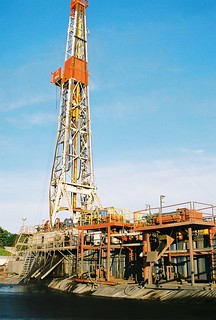 The manufacturing sector has been leading the US economic recovery since the end of the Great Recession in 2009. One of the key drivers in the manufacturing recovery is the renaissance in domestic production of natural gas and, to a lesser extent, oil. On November 28, the Institute’s program on Manufacturing and Society in the 21st Century will host an event exploring the ramifications of recent developments in energy and manufacturing, and the sustainability of the production boom for the future.
The manufacturing sector has been leading the US economic recovery since the end of the Great Recession in 2009. One of the key drivers in the manufacturing recovery is the renaissance in domestic production of natural gas and, to a lesser extent, oil. On November 28, the Institute’s program on Manufacturing and Society in the 21st Century will host an event exploring the ramifications of recent developments in energy and manufacturing, and the sustainability of the production boom for the future.
Growth in domestic energy production, driven by the deployment of new exploration and drilling technologies, has been an economic turning point in the US for a number of reasons. Not the least of these is the possibility of reaching the US’ long-term goal of energy independence, a goal which arguably has already been reached, if North America is considered the proper unit for determining independence. The substitution of natural gas for coal in electricity production and process heat in manufacturing, as well as the growing use of natural gas in transportation, also contribute to lowering greenhouse gas emissions. The Department of Energy’s estimates of future carbon emissions show a 69 percent drop in expected emissions from 2002 to 2030 compared to projections from 1990. Finally, overall economic growth is strengthened considerably by the energy boom. Not only is the United States producing more energy, it will also be building more petrochemical refineries, will supply the equipment needed to build the exploration and refining infrastructure, and almost every energy user—from households to large manufacturers—will benefit from more secure supplies and lower costs.
Manufacturing is at a pivotal point in this emerging energy economy. It uses about one-third of all energy produced in the United States, so lower prices and more secure supply give almost all firms in the sector a competitive advantage over firms in other nations. Relative to the United States, the spot price of natural gas is nearly three times more expensive in Europe and four times more expensive in most of Asia. This advantage is especially important in the chemicals industry, which is the second largest subsector of US manufacturing. Natural gas and associated liquids represent over 80 percent of the feedstock for US refineries, whereas in Europe and Asia the ratios are roughly two-thirds oil and one-third natural gas. When the price differential between natural gas and oil is taken into account, the advantage to the American chemicals sector comes into much sharper relief. The US manufacturing sector benefits in many other ways: lower process heat costs, a globally competitive advantage in building the energy and refinery infrastructure driving the renaissance, and the stability of supply which will help attract long-term investment in subsectors like steel, glass, aluminum, and metal working. Finally, a larger share of GDP for a growing manufacturing sector helps to improve living standards, since productivity growth is so strong in this sector. Since 1998, manufacturing productivity has grown at an annual rate of 3.5 percent, over twice as much as the 1.4 percent in the services sector.
In the last few decades, manufacturing — which faces steadily growing foreign competition and must innovate to protect its market share — has steadily improved the energy efficiency of production. Total carbon emissions in this sector have fallen by nearly one-fourth since 1998, even though total output has increased by about a third. As a result, carbon emissions per dollar of output in manufacturing have fallen by 36 percent since 1998, compared to only 20 percent in the overall economy. This is due in part to the substitution of natural gas, in part due to productivity increases, and in part due to higher use of renewable energy—manufacturing uses 90 percent more renewables than the transportation sector.
Are these trends in energy production and manufacturing sustainable? What are the sectors most likely to benefit? What are the environmental consequences of this transformation? What policy decisions would strengthen or weaken these trends? Come join our panel on Wednesday to explore these questions. The conversation will feature Calvin Dooley from the American Chemistry Council, Thomas Peterson of the Center for Climate Strategies and Harold Sirkin from the Boston Consulting Group. If you are unable to make it, a livestream of the event will be available here.
Photo used under Creative Commons from Flickr user Ari Moore.

